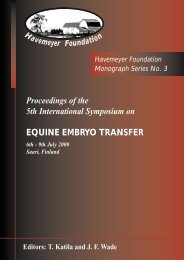Proceedings of a Workshop on - The Havemeyer Foundation
Proceedings of a Workshop on - The Havemeyer Foundation
Proceedings of a Workshop on - The Havemeyer Foundation
Create successful ePaper yourself
Turn your PDF publications into a flip-book with our unique Google optimized e-Paper software.
Equine Recurrent Laryngeal Neuropathy<br />
ENDOSCOPIC GRADING SYSTEMS FOR LARYNGEAL<br />
PARALYSIS - 6 GRADE SYSTEM<br />
P. M. Dix<strong>on</strong><br />
Divisi<strong>on</strong> <str<strong>on</strong>g>of</str<strong>on</strong>g> Veterinary Clinical Studies, <strong>The</strong> University <str<strong>on</strong>g>of</str<strong>on</strong>g> Edinburgh, Easter Bush Veterinary Centre,<br />
Easter Bush, Midlothian, EH25 9RG, UK<br />
<strong>The</strong>re is general agreement that laryngeal<br />
endoscopy is currently the gold standard for<br />
diagnosing equine laryngeal paralysis. Endoscopic<br />
evaluati<strong>on</strong> during high-speed treadmill exercise is<br />
even more accurate in the rare cases that show<br />
normal laryngeal functi<strong>on</strong> (including laryngeal<br />
asynchr<strong>on</strong>y and arytenoid shivering) at rest, but<br />
have a significant deteriorati<strong>on</strong> during fast<br />
exercise. Treadmill endoscopy is also the optimal<br />
technique for assessing degree <str<strong>on</strong>g>of</str<strong>on</strong>g> laryngeal<br />
abductor dysfuncti<strong>on</strong>, which is determined most<br />
accurately at fast work (Morris and Seeherman<br />
1990). However, facilities for treadmill endoscopy<br />
are limited and such procedures involve training <str<strong>on</strong>g>of</str<strong>on</strong>g><br />
horses, delay in obtaining results, technical<br />
expertise and capital outlay. <strong>The</strong>refore, for the<br />
foreseeable future, resting endoscopy remains the<br />
standard method for diagnosis and assessing the<br />
degree <str<strong>on</strong>g>of</str<strong>on</strong>g> equine laryngeal paralysis.<br />
Resting laryngeal endoscopy using flexible<br />
endoscopes has been practiced for 30 years and<br />
there is widespread c<strong>on</strong>sensus that asynchr<strong>on</strong>y and<br />
shivering (usually left sided) <str<strong>on</strong>g>of</str<strong>on</strong>g> a larynx that can<br />
obtain and maintain full abducti<strong>on</strong> are generally<br />
insignificant. Such findings are now rarely viewed<br />
with the same degree <str<strong>on</strong>g>of</str<strong>on</strong>g> suspici<strong>on</strong> as they were<br />
prior to work such as that <str<strong>on</strong>g>of</str<strong>on</strong>g> Morris and<br />
Seeherman (1990) who showed c<strong>on</strong>clusively that<br />
horses with laryngeal asynchr<strong>on</strong>y and flutter can<br />
maintain normal laryngeal functi<strong>on</strong> during high<br />
speed treadmill endoscopy.<br />
In the author’s opini<strong>on</strong>, even permanent, low<br />
degrees <str<strong>on</strong>g>of</str<strong>on</strong>g> laryngeal asymmetry can be present<br />
with no or minimal functi<strong>on</strong>al effects. High-speed<br />
treadmill endoscopy <str<strong>on</strong>g>of</str<strong>on</strong>g> such cases has shown<br />
normal laryngeal functi<strong>on</strong> during strenuous<br />
exercise. <strong>The</strong> author also disagrees with any<br />
classificati<strong>on</strong> system, which rates normal functi<strong>on</strong><br />
as ‘Grade 1’ <str<strong>on</strong>g>of</str<strong>on</strong>g> that dysfuncti<strong>on</strong>. It must be more<br />
rati<strong>on</strong>al to have normal as zero, with increasing<br />
degrees <str<strong>on</strong>g>of</str<strong>on</strong>g> dysfuncti<strong>on</strong> classified numerically.<br />
<strong>The</strong> widely used laryngeal paralysis grading<br />
system <str<strong>on</strong>g>of</str<strong>on</strong>g> Ducharme et al. (1989) and Hackett et al.<br />
(1991) separated laryngeal functi<strong>on</strong> into 4 grades, ie<br />
totally synchr<strong>on</strong>ous; asynchr<strong>on</strong>y/flutter;<br />
asymmetry; and total hemiplegia. However, the<br />
major disadvantage <str<strong>on</strong>g>of</str<strong>on</strong>g> that system is that it<br />
classifies all asymmetry (incomplete abducti<strong>on</strong>) <str<strong>on</strong>g>of</str<strong>on</strong>g><br />
the larynx into a single category. C<strong>on</strong>sequently,<br />
horses with very mild asymmetry (which may be<br />
functi<strong>on</strong>ally normal) are classified in the same<br />
group as horses with almost total laryngeal<br />
paralysis which, during treadmill exercise, will<br />
have a grossly abnormal larynx. <strong>The</strong> sub-divisi<strong>on</strong> <str<strong>on</strong>g>of</str<strong>on</strong>g><br />
this category into 3 subgroups provides a 6-grade<br />
system, which allows a better assessment <str<strong>on</strong>g>of</str<strong>on</strong>g><br />
laryngeal functi<strong>on</strong>, as illustrated in Table 1 (Dix<strong>on</strong><br />
et al. 2004). <strong>The</strong> 5-grade system <str<strong>on</strong>g>of</str<strong>on</strong>g> Lane (1993)<br />
partially addressed this issue but it is believed that<br />
the proposed 6-grade system is more advantageous.<br />
Emberts<strong>on</strong> (1997) also sub-divided the resting<br />
endoscopic grades <str<strong>on</strong>g>of</str<strong>on</strong>g> recurrent laryngeal<br />
neuropathy (RLN) that describe asymmetric<br />
movements into 2 grades, and Hammer et al. (1998)<br />
sub-divided this same grade, as assessed during<br />
high speed treadmill exercise, into 3 grades.<br />
For a resting endoscopic examinati<strong>on</strong>, the<br />
endoscope is inserted via the right ventral meatus<br />
and positi<strong>on</strong>ed midline in the nasopharynx. <strong>The</strong><br />
symmetry and synchr<strong>on</strong>y <str<strong>on</strong>g>of</str<strong>on</strong>g> arytenoids is<br />
observed during quiet breathing, following<br />
swallowing (induced by trans-endoscopically<br />
flushing water through the nasopharynx) and<br />
during temporary nostril occlusi<strong>on</strong> (to assess the<br />
degree <str<strong>on</strong>g>of</str<strong>on</strong>g> maximal arytenoid abducti<strong>on</strong>).<br />
In a study where 2 independent observers<br />
endoscopically examined and graded 45 horses<br />
using the above 6-grade laryngeal endoscopic<br />
26








